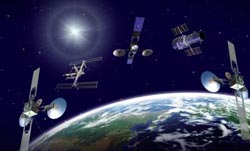All systems go for next communication spacecraft

Three TDRS satellites, the International Space Station (ISS) and Hubble Space Telescope orbit a blue-green Earth in this artist's concept. The TDRS network facilitates around the clock communication access between ground stations and other satellites and the ISS. Credit: NASA/Goddard Space Flight Center<br>
Approval to move forward came during a recent Agency Project Management Council (APMC) meeting at NASA Headquarters. “I am very proud of the entire TDRS civil servant and contractor team for successfully completing this milestone and demonstrating that the TDRS project is ready to proceed into the integration phase,” said Jeff Gramling, TDRS Project Manager.
“I am excited to see the TDRS-K satellite enter the thermal vacuum chamber and begin environmental testing.” Testing will occur within the Boeing Space Systems Facility in El Segundo, California.
APMC approval allows the project to enter Phase D that will include spacecraft integration and testing. During this phase the spacecraft reflectors will be mounted, the thermal panels and batteries will be installed before the spacecraft will have to endure the rigors of the vibration and acoustic testing. Finally, the spacecraft must pass a pre-ship review prior to being transported to Florida for launch.
Prior to the APMC approval, the project successfully completed a combined Pre-Environment Review (PER) and Systems Integration Review (SIR) in August of this year. The SIR is a significant milestone in the NASA mission lifecycle. During the upcoming environmental test phase, various segments and subsystems are scrutinized for their viability under the same harsh conditions they will endure within the vacuum of space.
“Successful completion of the environmental testing phase of the project will be the last step before we ship the TDRS-K spacecraft to the launch site,” said Dave Littmann, TDRS Deputy Project Manager. “Through a rigorous testing program, we will ensure this satellite, once on-orbit, is capable of meeting its functional and performance requirements, to provide reliable services to the customers of NASA's Space Network.”
This next generation space communications satellite is part of a follow-on spacecraft fleet being developed and deployed to replenish NASA's Space Network. The TDRS Project Office at Goddard Space Flight Center manages the TDRS development effort. TDRS is the responsibility of the Space Communications and Navigation (SCaN) office within the Human Exploration and Operations (HEO) Mission Directorate at NASA Headquarters in Washington D.C. Operations of the network is the responsibility of the Space Network Project at Goddard.
In December 2007, NASA signed a contract for Boeing Space Systems to build two, third generation TDRS spacecraft for launch in 2012 and 2013. Within the contract were the required modifications that will enable the White Sands Complex ground system to support the new spacecraft.
The launch of TDRS-K will begin the replenishment of the fleet through the development and deployment of the next generation spacecraft. These satellites will ensure NASA's Space Network continues to provide around-the-clock, high throughput communications services to NASA's missions and serving the scientific community and human spaceflight program for years to come.
For more information about TDRS visit: http://tdrs.gsfc.nasa.gov
Media Contact
More Information:
http://www.nasa.govAll latest news from the category: Physics and Astronomy
This area deals with the fundamental laws and building blocks of nature and how they interact, the properties and the behavior of matter, and research into space and time and their structures.
innovations-report provides in-depth reports and articles on subjects such as astrophysics, laser technologies, nuclear, quantum, particle and solid-state physics, nanotechnologies, planetary research and findings (Mars, Venus) and developments related to the Hubble Telescope.
Newest articles

Properties of new materials for microchips
… can now be measured well. Reseachers of Delft University of Technology demonstrated measuring performance properties of ultrathin silicon membranes. Making ever smaller and more powerful chips requires new ultrathin…

Floating solar’s potential
… to support sustainable development by addressing climate, water, and energy goals holistically. A new study published this week in Nature Energy raises the potential for floating solar photovoltaics (FPV)…

Skyrmions move at record speeds
… a step towards the computing of the future. An international research team led by scientists from the CNRS1 has discovered that the magnetic nanobubbles2 known as skyrmions can be…





















